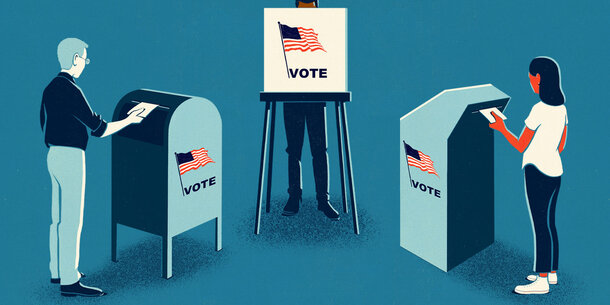A new Brennan Center survey of local election officials from around the country shows that many election officials have left the field, and more plan to go. In 2020, confronted with the Covid-19 pandemic, election officials ran what the key government agencies at the time called the “most secure election in American history” with the highest voter turnout in over 100 years. But since then, the election officials have found themselves targeted by a campaign to lie about election results and undermine faith in American democracy.
Scapegoated for election outcomes that some politicians and voters did not like, many election officials have faced death threats, online harassment, and abuse. Political leaders interfered in their work by censuring or replacing some officials who told the truth about election security, and in some states they enacted new laws exposing officials to criminal penalties for minor infractions or for taking proactive steps to help their voters.
The result is hollowing out the ranks of experienced election administration professionals, with potentially more to come in the next year. The survey found that 12 percent of local election officials began their service after the 2020 election cycle. Another 11 percent of current officials say they are very or somewhat likely to leave before November 2024. If these officials follow through and exit their positions, we will have lost approximately 1.5 election officials per day between the November 2020 and 2024 elections.
The loss of institutional knowledge that accompanies such high turnover can mean that election officials are less aware of resources available to assist them in securing and running their elections. Large numbers of resignations can also result in more administrative mistakes, which can in turn fuel conspiracy theories and threats, continuing the cycle that has led to resignations in the first place.
The findings of our survey provide some explanation as to why election officials continue to leave office at high rates, as well as some clues as to what can be done to staunch the bleeding and offer support where it is needed most, particularly to the field’s newest members.
Dangers on the job
Threats, abuse, and harassment continue to be a significant concern in the field. Cathy Darling Allen, the clerk and registrar of voters of Shasta County, California, has described fearing for the safety of her staff after discovering a surveillance camera planted at the back entrance of her office used by poll workers during the 2022 primary. At least one other official discovered a wireless video camera aimed at his front door. In Gillespie County, Texas, election staff endured several kinds of harassment, including volunteer poll watchers calling the police and filming staff in a dark parking lot, attempting to forcibly enter a secure ballot vault, and stalking and threatening some staffers. In August 2022, the entire staff resigned, with at least one person citing threats in her resignation letter.
This issue is not limited to a small number of places: our survey shows that nearly one in three election officials have been harassed, abused, or threatened because of their job. Alarmingly, more than one in five are concerned about being physically assaulted on the job in future elections. Election officials worry about their colleagues, with 45 percent of respondents expressing concern for the safety of other election officials and workers in future elections. Not surprisingly then, more than half of respondents expressed concern that the attacks will make it more difficult to retain or recruit election workers in future elections.
Lack of funding hurts election security
At the same time, 74% of local election officials say they need their annual budget to grow to address security and election administration needs over the next five years. Election systems are critical infrastructure vital to our democracy and national security, and Congress’s unwillingness to provide adequate funding is a significant failure. While the Department of Homeland Security’s announcement requiring more federal grant money be dedicated to election security was a step in the right direction, our survey shows there is more work to do.
Election officials say increased funding would allow them to invest in more poll workers and improved voting equipment, as well as strengthen cybersecurity and the physical security of election offices. Many election officials have sought to secure their offices following threats. An election official in Jackson County, Oregon asked the state for about $80,000 to install bullet-resistant glass and transaction windows at certain office counters after the parking lot was painted with threatening language. The Brennan Center has estimated that implementing basic physical security measures to protect election workers would cost about $300 million over the next five years.
Our survey shows that election officials are unable to adopt basic physical and cybersecurity measures because they do not have the funds to do so. Of the 49 election officials we interviewed who availed themselves of free cyber hygiene scans provided by DHS’s Cybersecurity and Infrastructure Security Agency and the 54 who received their free physical security assessments, the vast majority implemented at least some of the recommended improvements. But in each category, only 10 adopted all recommendations. Of those who did not adopt more recommendations, lack of funds was the top reason why not.
Political interference
Election officials continue to express concern about political interference in alarmingly high numbers. In the aftermath of the 2020 election, many election officials faced pressure from political leaders to certify certain election outcomes. President Trump notoriously called Georgia Secretary of State Brad Raffensperger to ask him to “find 11,780 votes.” In 2021, Arizona legislators transferred powers from the state’s Democratic secretary of state over to the attorney general, apparently to prevent the settlement of lawsuits aiming to improve voter access. In Wisconsin and Arizona, sham partisan reviews of the 2020 election were used to misrepresent the work of election officials and cast doubt on legitimate results.
Many local election officials see this threat of political interference as ongoing, with 56 percent reporting that they are either somewhat or very worried about political leaders engaging in efforts to interfere with how their fellow election officials do their jobs. And more than one in nine say they are concerned about facing pressure to certify election results in favor of a specific candidate or party in future elections.
Federal support
Most election officials feel that the federal government could be doing more to help, with only 27 percent saying that the federal government is doing a “good job” supporting them in their roles. Election officials have reason to complain. In addition to the $300 million mentioned above for protecting election workers from new threats and violence, the Brennan Center has also estimated the cost of protecting against insider threats as a result of growing belief in conspiracy theories around elections could similarly exceed $300 million. Further, we estimated in 2022 that the cost to replace polling place voting machines that are aging out is nearly $600 million over the following 5 years. Despite these massive numbers, Congress provided just $75 million in new money for elections last year.
While this failure is frustrating, it’s also worth noting many election officials aren’t aware of the full range of federal services available to them, such as federal grant programs and communications toolkits. This lack of awareness is also an opportunity for the federal government. As soon as possible, federal agencies that provide resources to election officials should develop a comprehensive and coordinated communications plan to establish regular contact with election officials through the 2024 election, promote federal funding opportunities and resources, and provide election officials with a venue to highlight questions and concerns.
• • •
By and large, the 2022 election was a success for election administration. There was limited violence, courts pushed back on efforts to refuse to certify elections, and election deniers lost key governor and secretary of state contests.
With the 2024 presidential election approaching, now is the time to ask what we can do to further strengthen election administration. It’s clear that many election officials still feel they face a hostile environment, with more than 1 in 10 saying they very or somewhat likely to exit their office in the relatively short time before November 2024. We should work to strengthen cyber and physical protections for election offices, increase funding, and elevate available resources for election officials.
Note on Methodology: Our calculation for the rate of turnover among election officials was made as follows: there are approximately 10,000 local election officials in the United States. In our survey, 12 percent of election officials stated they had replaced their predecessors after November 2020, amounting to 1,200 officials. About 900 days passed between the November 2020 election and when the poll was conducted: 1,200 officials divided by 900 days equals roughly 1.34. 11 percent of officials are unlikely to continue serving through November 2024, amounting to 1,100 officials. 1,100 officials divided by 560 days until the November 2024 election equals roughly 1.96.








